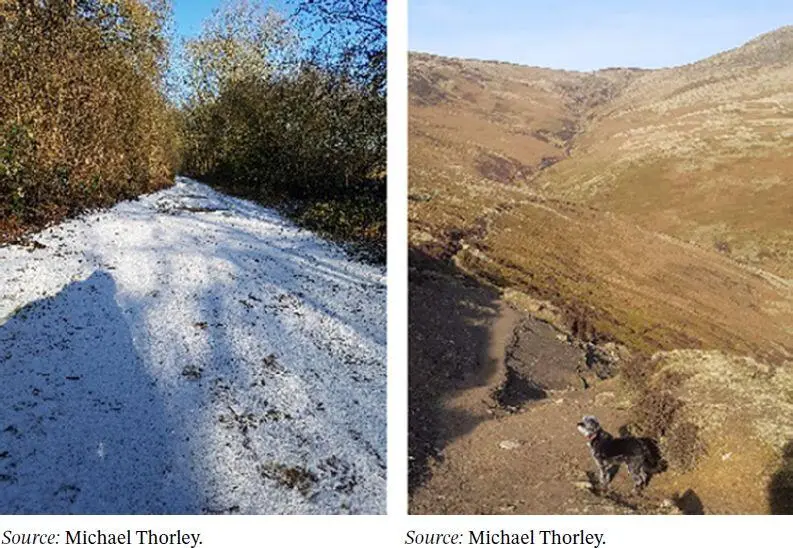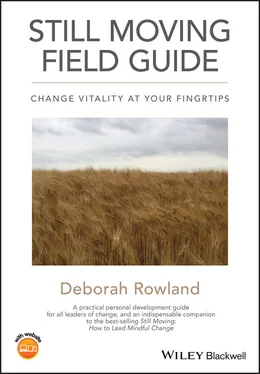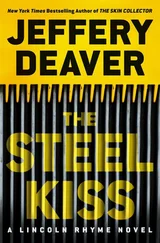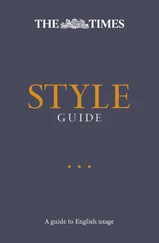Notice your immediate responses to the above paragraph and keep noticing everything in you, in others, and in the wider world as you engage with this well‐researched, practical guide in how “to be” and how “to do” in order to lead ongoing complex change.
The Field Guide has a structure that defines each of the four Still Moving Change Vitality Factors and then breaks them down into their individual Elements. We are immediately given a sense of an integrated, emergent whole. In the rest of the Guide , each Element is defined in detail; there is a section on why this Element is so important in leading change, a section on how to self‐rate against it, and, most importantly, some helpful coaching pointers for how to cultivate greater leadership in each area. Each section ends with further reading and resources, and a blank page on which you can jot down any noticing and thoughts. Journaling, itself, is a mindful practice!
Effective leadership is increasingly demanded, but what do we mean by that? There is a real awakening of the relevance of self in relation. There are, sadly, too many attempts to categorize elements of the human condition into tools. Take, for example, the use of empathy as a tool to be used in Design Thinking. It focuses solely on putting yourself in the shoes of the other, but not actually checking in with your own experience of who being you is and how you then see the other.
The Still Moving Field Guide does not define or make rules. It does not attempt to define good or bad, nor should it. It does not purport to put you in a box. In a way it is itself, rightly in my view, presenting a paradox—it guides but does not lead anywhere. That in itself for many can be uncomfortable. At the same time the authenticity of the approach shines through. The Guide creates an invitation to discovery and dialogue as a continuous emerging process in the service of purpose.
The author asserts that the development of Still Moving change leadership is not easy, and this Field Guide enables us to make sense of how to navigate that continuous integrated journey of the mind, the body, and the spirit of leadership in a deeply connected world. It does not shy away from difficult concepts such as the systemic Ordering Forces, the evidence of which is being newly discovered in the field of Quantum Entanglement. The Guide uses language with a focus on the lived experience of leading change, which invites us to stop, reflect, and respond differently to create the conditions for change.
Alongside my leadership in organizations as diverse as the religious, health, prison, FMCG (fast‐moving consumer goods), and industrial engineering sectors, I am an enthusiastic amateur marathon runner and when I was training, I got curious about how training for a marathon was very similar to leading in an organization. Change is a lived experience with actions and feelings taking place in the present moment. Leading organizationally and training for a marathon require a positive focus in the here and now. How am I standing? What do I experience when I look into the current experience? Such leadership includes a requirement and a willingness to both commit and let go, to become vulnerable and welcome the discomfort of change, and to deeply honor and stand in the strength of who we fully are without a yearning, striving desire to change. To stay with what is, to learn and reflect without striving or searching may sound odd, but having read this Field Guide I am beginning to understand more about leading and running.
As this is a practical guide, I took a practical approach to inquiring into two pictures below and invite you to join me in them. Both pictures are in a real as opposed to metaphorical field! They were routes I undertook for marathon training. Ask yourself about the beauty and opportunity contained within them. Were you tempted to see only difficulty “out there” and the challenge? Had you already defined the way to approach the change required to get ahead? Did you know best? Did you pause to look at the entire environment and sense what was present and how you might affect and be affected by it? In both scenarios, my approach was not to strive but to be in the present to meet and connect and be impacted by what is—as this Field Guide invites us to do. I did not do this alone—my four‐legged companion joined me! It helps to not go it alone in this work.

The beauty of the Field Guide is that it meets the reader wherever they are, both literally and figuratively. It can be read alongside the author's previous book, Still Moving: How to Lead Mindful Change , which charts the origin of these leading change dimensions and the research underpinning them—including the author's own personal journey. There is also a Change Vitality Indicator questionnaire available—in both individual and organizational formats—that can measure your current level of leading change capability and pinpoint fruitful strategies for enhancing how you go about change. Completing the questionnaire and reading the book deepens and enriches what is a continuous journey for us all.
The reluctance of the Field Guide to hold expert opinion for the reader creates the biggest challenge of all. We are invited to extend our way of being into the unknown to generate and then to make choices for ourselves in relation to intention and purpose within a greater, more intimate and connected world for which we are all responsible. It is most definitely not a Self‐Assembly toolkit (in the words of the Field Guide ) and hooray for that!
We learn many things, and the most important for me is to consider how yearning and striving can be replaced and enhanced by yielding and accepting. What will you discover?
Michael Thorley
Still Learning and Still Moving
Saturday, February 1, 2020
I have many people to thank who stand behind the writing of this book. First and foremost, I wish to thank my Still Moving colleagues. 1 In particular, I thank Michael Thorley, who provided indefatigable and insightful input to the descriptions of each of the Still Moving change leadership elements contained in the book, and Katie Jones, who diligently labored over its production, format, and artistic look and feel. Other colleagues who I'd like to thank are Nicole Brauckmann, Sytske Casimir, Phil Hadridge, Anjet van Linge, Belden Menkus, Darius Norrell, and Paul Pivcevic—not only for their contributions to the book's content, but also for their close work with me over the last 3 years in bringing the “Still Moving way of leading change” into ever‐increasing circles of practical application.
And that's what this Field Guide is for—illuminating how to put into practice, and develop, the skills I wrote of in Still Moving: How to Lead Mindful Change . Thank you, it's been a blast! This book is written from the “we” perspective as its content stands on all of our shoulders.
Widening out, I make a deep bow to the support from Jackie Gittins, who has acted as a wise counsel and champion for us in this work. I am also indebted to Roger Bellis and Helen Bellis for early conceptual development of the “Change Vitality” concept embedded within this Field Guide , including its stunning visual, the “Change Vitality cone”; to Judith Hemming, from whom I have exquisitely learned about the systemic Ordering Forces within our Change Vitality framework—my skill to work at depth as a change practitioner is to a large extent down to her insight and generous mentoring; and to Julian Burton, who is the artist behind the graphics illustrating each of the 16 elements of leading change within this Field Guide .
Читать дальше













